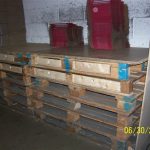We may receive a commission when you use our affiliate links. However, this does not impact our recommendations.
 I’m in the middle of building a bench for the shop. I’ve milled the legs from 8″-diameter posts down to 5″ square. They are really old and heavy. They have beautiful color and grain patterns. I’ve got four of them cut down to 36″ in length. That won’t be my final length, but it gives me some room to play, depending on the top I choose.
I’m in the middle of building a bench for the shop. I’ve milled the legs from 8″-diameter posts down to 5″ square. They are really old and heavy. They have beautiful color and grain patterns. I’ve got four of them cut down to 36″ in length. That won’t be my final length, but it gives me some room to play, depending on the top I choose.
For the last couple days, I’ve been playing around with ideas for the feet. I know – benches don’t have feet! But I’ve never cared for the way most benches have a straight block of wood going right into the floor. It looks so chunky to my eye – as if the legs are unresolved.
So I’ve been cutting some prototypes out on the 14″ band saw. I’ve been varying the degree of the cuts to see what kind of patterns I can expect for the grain of the wood and trying different profiles. I find the band saw to be the most fun of all the tools in the shop because it allows me to make some quick sketches. And you don’t even need to have a lot of scrap wood on hand. In the past, I’ve glued up some of those rigid pink insulation panels that you will find thrown away on construction sites.
• Check out ShopWoodworking.com for “The New Complete Guide to the Band Saw.“
Here are some supplies and tools we find essential in our everyday work around the shop. We may receive a commission from sales referred by our links; however, we have carefully selected these products for their usefulness and quality.








Interesting shapes… Can you tell me the kind of wood that is pls ?
Though I’m not sure you are looking for input, I’ll throw my vote in for the foot on the left – the side with the broadest arc. In fact I’d make the arc a little shallower so that it is more subtle. A ball and claw foot would be fun, though (as long as I’m not carving it…).
Following up on Mikex’s suggestion, why not a carved human hand and softball? You could get carried away with this and actually carve the wrist and forearm… Let’s see, finger placement for various pitches at each corner?
When I recently built a computer cabinet for my wife to use at work, so she could stand while using her computer, I used 20 degree tapers for the feet, which are about 2″x3″. My cabinet’s feet are much shorter than yours, but I found the taper, on all four sides, produced a nice subtle appearance. I also lucked out, since I was using cherry and there was a horizontal sap pocket that just so happened to lie at the transition from straight to taper. I thought the tapers you showed were a bit too extreme.
Well if you are going to do it that way, I definitely consider going with a ball and claw. Nothing like a massive claw gripping a softball sized ball to draw the eye, and it would be fun!
I like Josh’s idea of tapering the inside faces.
Also, assuming you’re going to follow the Schwarzian advice of making the bench as heavy as possible, don’t make the feet too small. For a given overall weight, the pressure on the foot goes inversely as the foot area. You want to avoid the spike heel effect (even a featherweight woman wearing spike heels can readily dent an oak floor).
-Steve
I don’t like the one on the left, I think it would look odd on a work bench.
I agree with tjhenrik that the one on the right has too small a foot.
What about making it like the ones commonly used on table legs, that taper on just the two inside faces? Might give it some style but still keep it hefty enough to have good stability.
Josh
The leg on the right seems to my amateur eye to sacrifice too much surface area between the foot and floor decreasing stability. The form on the left would sacrifice valuable clamping space though does have more flare if your bench will be of French influence.
-T
If you put a monster ball and claw on your workbench feet, you will officially be my hero.